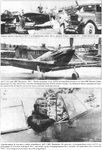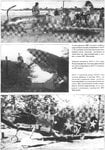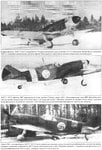Navigation
Install the app
How to install the app on iOS
Follow along with the video below to see how to install our site as a web app on your home screen.
Note: This feature may not be available in some browsers.
More options
You are using an out of date browser. It may not display this or other websites correctly.
You should upgrade or use an alternative browser.
You should upgrade or use an alternative browser.
LaGG-3 on Japan Air Force.
- Thread starter Mitya
- Start date
Ad: This forum contains affiliate links to products on Amazon and eBay. More information in Terms and rules
More options
Who Replied?Actually the question consists in the following. And there is a report either what else or the information on how Japanese have estimated trophy LaGG-3.
There are no reports that I know of, does not mean they do not exist. Im thinking that the aircraft was captured after VE-Day when the Russians helped come to the aid of the chinese towards the very end of WWII. Finding info on this subjects tends to be very hard especially in english. Ive only seen one article on the subject but cant read it do to it being in Russian and there for not exactly sure if it talks about the subject 100%. I do know that is shows a few russian troops capturing japanese aircraft.
- Thread starter
- #3
There are no reports that I know of, does not mean they do not exist. Im thinking that the aircraft was captured after VE-Day when the Russians helped come to the aid of the chinese towards the very end of WWII. Finding info on this subjects tends to be very hard especially in english. Ive only seen one article on the subject but cant read it do to it being in Russian and there for not exactly sure if it talks about the subject 100%. I do know that is shows a few russian troops capturing japanese aircraft.
Yes is not present. Business was so.
In the spring of 1942 one fighter have stolen from Transbaikalia in supervised then Japanese Manchuria. The plane has made an emergency landing on a field with the removedchassis. After repair Japanese have decided to test LaGG-3. Flights have begun from September, 29. Definition of the basic characteristics of the machine was carried out{was spent} and educational fights with the Japanese fighters were conducted. The further destiny of this plane is unknown...
Вот...
Very interesting Mitya and thanks for the date. Sounds like the Japanese had the aircraft in there postion alot longer then I thought.
You wouldnt by chance know where I could find some documention on japanese aircraft captured and tested by Russia or any other country for WWII would you?
Thanks in advance.
You wouldnt by chance know where I could find some documention on japanese aircraft captured and tested by Russia or any other country for WWII would you?
Thanks in advance.
- Thread starter
- #5
Very interesting Mitya and thanks for the date. Sounds like the Japanese had the aircraft in there postion alot longer then I thought.
You wouldnt by chance know where I could find some documention on japanese aircraft captured and tested by Russia or any other country for WWII would you?
Thanks in advance.
Finns used seized LaGG-3. Me interests, as Japanese have estimated this type of the plane... At one our forum has flown that Japanese have not badly estimated him enough. The truth it whether or not... In what business. In fact they even spent comparative tests with the aircraft. What results too I do not know...
Finns used seized LaGG-3.
Le.Lv.32 / HLe.Lv.12 used LaGGs ("LG-1, "LG-2" and "LG-3") in 1943 - 1944. The squadron had usually one LaGG per any given time and they were used to intercept Soviet Petljakovs. [1] The only kill with these captured planes was a Soviet LaGG-3!
Captain Pekka Kokko test flew the LG-3 on 8th February 1943. M-105 PF 3-1119, W-105 SWP. Weight 3240 kg (Fuel = 315, Guns = 71 + 69 kg). Rate of Climb was 15,6 m/s (radiator open) on 0-1000 m. Maximum speed at surface was 463 km/h. [2]
[1] Lentorykmentti 1:n toimintakertomus ajalta 1.5.1942 - 31.7.1944. SPK 25739 (F124/914). Finnish National Archive, Sörnäinen.
[2] Report on the test flight of LG-3. 1943. Valtion Lentokonetehdas.
The little information I have is from a book an illustraited guide to Allied Fighter of World War II, copyright 1981 Salamander Books Ltd and written by Bill Gunston. In it is a same picture and it's written that this LaGG-3 whas tested in Harbin after it whent to hands of the japanese forces when it landed in a plowed field in Manchuriet by an Russian deserter 1942. The japanese wherent impressed of the performance of this plane.
- Thread starter
- #8
I know it.Le.Lv.32 / HLe.Lv.12 used LaGGs ("LG-1, "LG-2" and "LG-3") in 1943 - 1944. The squadron had usually one LaGG per any given time and they were used to intercept Soviet Petljakovs. [1] The only kill with these captured planes was a Soviet LaGG-3!
Captain Pekka Kokko test flew the LG-3 on 8th February 1943. M-105 PF 3-1119, W-105 SWP. Weight 3240 kg (Fuel = 315, Guns = 71 + 69 kg). Rate of Climb was 15,6 m/s (radiator open) on 0-1000 m. Maximum speed at surface was 463 km/h. [2]
[1] Lentorykmentti 1:n toimintakertomus ajalta 1.5.1942 - 31.7.1944. SPK 25739 (F124/914). Finnish National Archive, Sörnäinen.
[2] Report on the test flight of LG-3. 1943. Valtion Lentokonetehdas.
- Thread starter
- #9
The little information I have is from a book an illustraited guide to Allied Fighter of World War II, copyright 1981 Salamander Books Ltd and written by Bill Gunston. In it is a same picture and it's written that this LaGG-3 whas tested in Harbin after it whent to hands of the japanese forces when it landed in a plowed field in Manchuriet by an Russian deserter 1942. The japanese wherent impressed of the performance of this plane.
And is detailed that is not present?
- Thread starter
- #10
I know it.Also I ask, and how Japanese of ihim estimated?

What? Please, explain again. You have seen the Finnish report before or you knew that Finns have LaGG-3s?
Hi Mangrove,
>Captain Pekka Kokko test flew the LG-3 on 8th February 1943. M-105 PF 3-1119, W-105 SWP. Weight 3240 kg (Fuel = 315, Guns = 71 + 69 kg). Rate of Climb was 15,6 m/s (radiator open) on 0-1000 m. Maximum speed at surface was 463 km/h. [2]
Hm, is the weight correct? I only ask because I read somewhere that the M-105PF engined variant was lightened, so I'd like to be sure there is no typo in the data
The maximum speed appears comparatively slow, too - according to some Russian data, the LaGG-3 with the less powerful M-105P engine made 475 km/h @ sea level.
(Not that this would be the only captured aircraft to under-perform ...)
Regards,
Henning (HoHun)
>Captain Pekka Kokko test flew the LG-3 on 8th February 1943. M-105 PF 3-1119, W-105 SWP. Weight 3240 kg (Fuel = 315, Guns = 71 + 69 kg). Rate of Climb was 15,6 m/s (radiator open) on 0-1000 m. Maximum speed at surface was 463 km/h. [2]
Hm, is the weight correct? I only ask because I read somewhere that the M-105PF engined variant was lightened, so I'd like to be sure there is no typo in the data
The maximum speed appears comparatively slow, too - according to some Russian data, the LaGG-3 with the less powerful M-105P engine made 475 km/h @ sea level.
(Not that this would be the only captured aircraft to under-perform ...)
Regards,
Henning (HoHun)
- Thread starter
- #13
What? Please, explain again. You have seen the Finnish report before or you knew that Finns have LaGG-3s?
You not quick-witted what...
To you Finns.
You about Japanese better that would find.
Attachments
Hm, is the weight correct? I only ask because I read somewhere that the M-105PF engined variant was lightened, so I'd like to be sure there is no typo in the data
Hello Henning!
"LG-3" was weightened before the test and following values were marked down.
"Fuselage, engine and basic equipment": 2511 kg
"Pilot and his gear": 95 kg
"Fuel 450 L, Coolant and Oil": 480 kg
"12,7mm + 20mm + Radio": 85 kg
"Ammunition. 200x12,7mm + 140x20mm": 69 kg
This gives us 3240 kg.
The maximum speed appears comparatively slow, too - according to some Russian data, the LaGG-3 with the less powerful M-105P engine made 475 km/h @ sea level.
Are you sure the Soviets tested their planes with full load and such? I'm asking this because sometimes the test are flown without realistic loads.
The differences at the speeds can be explained in two ways.:
1) The Finns didn't use their engines at maximum manifold pressure for the test because it would damage the engine. Report says the (corrected) pressure used was 1030 mm Hg.
2) The Soviets didn't use as much equipment at their planes as the Finns did. Finns always tested their planes at Full Combat Load.
Cheers
Martti
Hi Martti,
>"LG-3" was weightened before the test and following values were marked down.
Thanks! That looks like a good breakdown ... and I have also calculated back the weight from some Russian charts that use a weight-based index, and it seems that they used a similar weight for the LaGG-3, too.
That looks like a good breakdown ... and I have also calculated back the weight from some Russian charts that use a weight-based index, and it seems that they used a similar weight for the LaGG-3, too.
>Are you sure the Soviets tested their planes with full load and such? I'm asking this because sometimes the test are flown without realistic loads.
I know little about the actual Soviet tests ... if they'd have used a different reference weight, I might have missed that detail. The RAF sometimes used something like 96% of the actual take-off weight for speed tests, but that makes only a minor difference.
>Report says the (corrected) pressure used was 1030 mm Hg.
Ah, great that the Finns documented their tests in detail! The engine chart I have indicates 1.43 ata = 1052 mm Hg. Minor difference, but it might yield 5 km/h speed difference at sea level. (Were the rpm stated, too? My engine chart is for 2700 rpm.)
The engine chart I have indicates 1.43 ata = 1052 mm Hg. Minor difference, but it might yield 5 km/h speed difference at sea level. (Were the rpm stated, too? My engine chart is for 2700 rpm.)
Another question: Were the speed tests was flown with radiator flaps open, too? That might make quite a pronounced difference for top speed values, of course.
I have to admit that I couldn't find out the propeller diameter of the LaGG-3 accurately yet. From measuring a threeview, I assume it's 2.95 m, but if you have a different figure, that would be most welcome, too
Regards,
Henning (HoHun)
>"LG-3" was weightened before the test and following values were marked down.
Thanks!
>Are you sure the Soviets tested their planes with full load and such? I'm asking this because sometimes the test are flown without realistic loads.
I know little about the actual Soviet tests ... if they'd have used a different reference weight, I might have missed that detail. The RAF sometimes used something like 96% of the actual take-off weight for speed tests, but that makes only a minor difference.
>Report says the (corrected) pressure used was 1030 mm Hg.
Ah, great that the Finns documented their tests in detail!
Another question: Were the speed tests was flown with radiator flaps open, too? That might make quite a pronounced difference for top speed values, of course.
I have to admit that I couldn't find out the propeller diameter of the LaGG-3 accurately yet. From measuring a threeview, I assume it's 2.95 m, but if you have a different figure, that would be most welcome, too
Regards,
Henning (HoHun)
The book "Japanese Army Captured Aircraft-Secret Files" by K. Oshio and S. Nohara adds:Yes is not present. Business was so.
In the spring of 1942 one fighter have stolen from Transbaikalia in supervised then Japanese Manchuria. The plane has made an emergency landing on a field with the removedchassis. After repair Japanese have decided to test LaGG-3. Flights have begun from September, 29. Definition of the basic characteristics of the machine was carried out{was spent} and educational fights with the Japanese fighters were conducted. The further destiny of this plane is unknown...
the a/c was tested by the CO of the 85th Fighter Regiment G. Yamamoto and a Sgt Yoshida. The a/c had to be repaired from the belly landing, and again when Japanese ground troops mistook it for an intruder and hit it with ground fire. This was in test in the Mudanjiang area in Manchuria. The a/c was later flown to Japan but wrecked in a landing accident along the way.
The book gives performance figures which presumably come the tests, since not the same as standard sources, but I'm not 100% sure, and some numbers look a little strange:
max speed 493 km/h at s/l
518km/h at 2,400m
(the book lists an alt of 4280m but then doesn't give the speed, typo in the book?, it's also possible the other two speeds are for 2.4km and 4.3km)
time to 3,000m: 3 min-40 sec
to 5,000m: 7 min-6 sec
to 8,000m: 17 min-13 sec
Some other accounts say this LAGG-3 was tested head to head v captured P-40 and Type 3 ('Tony'), all somewhat similar in basic arrangement and appearance, but this seems doubtful based on above account. The a/c based in Manchuria at the time, for informal tests, were Type 97 ('Nate') Type 1 ('Oscar') and Type 2 ('Tojo').
Bergstrom and Mikhailov in "Black Cross Red Star" Vol 1 discuss how individual examples of Soviet fighters produced ca. 1941-42 could have real performance much less than theoretical, more plane to plane variation than would usually be expected.
Joe
(Were the rpm stated, too? My engine chart is for 2700 rpm.)
Kokko flew the track with 2600 rpm
Another question: Were the speed tests was flown with radiator flaps open, too? That might make quite a pronounced difference for top speed values, of course.
I assume the speed track was flown radiators full open too.
I have to admit that I couldn't find out the propeller diameter of the LaGG-3 accurately yet. From measuring a threeview, I assume it's 2.95 m, but if you have a different figure, that would be most welcome, too
There's no diameter for the propeller but the distance from the tip of the propeller to a vertical line below the wheels is 2285 / 1835 / 1511 mm, when α is +12°, 0° and -7,5°.
Post Scriptum. According to the report the maximum output for a M-105 PF is 1100 HP.
Martti
- Thread starter
- #18
Hello Henning!
"LG-3" was weightened before the test and following values were marked down.
"Fuselage, engine and basic equipment": 2511 kg
"Pilot and his gear": 95 kg
"Fuel 450 L, Coolant and Oil": 480 kg
"12,7mm + 20mm + Radio": 85 kg
"Ammunition. 200x12,7mm + 140x20mm": 69 kg
This gives us 3240 kg.
Are you sure the Soviets tested their planes with full load and such? I'm asking this because sometimes the test are flown without realistic loads.
The differences at the speeds can be explained in two ways.:
1) The Finns didn't use their engines at maximum manifold pressure for the test because it would damage the engine. Report says the (corrected) pressure used was 1030 mm Hg.
2) The Soviets didn't use as much equipment at their planes as the Finns did. Finns always tested their planes at Full Combat Load.
Cheers
Martti
Yes. Are sure. In the USSR measured characteristics at full loading.
To you results:
I have asked not about Finns! I have asked about Japanese! Can not we shall flooding, and we shall answer in essence? Please. And? About Japanese LaGG in general that it is not known such... That me interests.
Attachments
- Thread starter
- #19
Thank You? Joe!...Bergstrom and Mikhailov in "Black Cross Red Star" Vol 1 discuss how individual examples of Soviet fighters produced ca. 1941-42 could have real performance much less than theoretical, more plane to plane variation than would usually be expected...
Joe
I have asked not about Finns! I have asked about Japanese! Can not we shall flooding, and we shall answer in essence? Please. And? About Japanese LaGG in general that it is not known such... That me interests.
I beg your pardon! I don't think the Finnish LaGGs are generally known at the Aviation World so I though it would be nice to post a report on the test flights on this thread. Afte rall this is a "forum", a place to discuss things.
Users who are viewing this thread
Total: 1 (members: 0, guests: 1)






